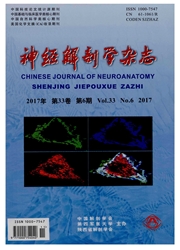

 中文摘要:
中文摘要:
目的:探讨盘状结构域受体酪氨酸激酶(discoidin domain recetor1,DDRl)蛋白在局灶性脑缺血致血脑屏障损伤中的作用机制及其病理性意义。方法:成年雄性sD大鼠80只,体重280—320g,采用随机数字表法,将其随机分为假手术组、缺血再灌注组、siRNA处理组和siRNA错配组,每组5只。采用大鼠大脑中动脉线栓法制备局灶性脑缺血再灌注模型,缺血120min再灌注24h时进行神经行为学评分,随后处死大鼠取脑,分别采用TIC(2,3,5-triphenyl tetrazolium chloride)染色法、干湿比重法、伊文思蓝法测定脑梗死体积、脑组织含水量及血脑屏障的通透性。结果:与假手术组比较,脑缺血再灌注组神经行为学评分降低(P〈0.05),脑梗死体积百分比增加,缺血侧脑组织含水量增多(P〈0.05),血脑屏障的通透性增大(P〈0.01);与局灶性脑缺血再灌注组比较,DDR1-siRNA处理组神经行为学评分升高,脑梗死体积百分比减少,脑组织含水量减少(P〈0.05),血脑屏障通透性降低(P〈0.01)。结论:DDR1蛋白可能参与了脑缺血再灌注损伤后血脑屏障的破坏,抑制DDRl的表达可降低血脑屏障的通透性;另外,检测DDR1的表达可作为脑卒中早期诊断和判断预后的分子指标之一。
 英文摘要:
英文摘要:
Objective: To explore the effect and mechanism of discoidin domain receptor 1 (DDR1) on blood brain barrier impairment after focal cerebral ischemia-reperfusion in rats. Methods: 80 adult male SD rats, weighing 280 N 320 g, were randomly divided into the sham group, the middle cerebral artery occlusion (MCAO) group, the DDRI-siRNA group and the scramble siRNA group ( n = 5 ). Focal cerebral ischemia was induced by MCAO in rats. At 24 h after the reperfusion following 120 min ischemia, TI'C staining, dry/wet weight method and Evans blue dye extravasation were applied to quantify infarction volume, brain water content and blood-brain barrier impairment, respectively. Neurological deficit scores were also evaluated. Results: The neurological score was significantly lower in the MCAO group than in the sham group ( P 〈 0.05 ). The focal cerebral infarction volume percentage, brain water content and blood-brain barrier impairment were significantly higher in the MCAO group than in the sham group(P 〈0.05, P 〈0.01 ). Compared with the MCAO group, The focal cerebral infarction volume percentage, brain water content and blood-brain barrier impairment were significantly lower in the DDRI-siRNA group(P 〈0.05, P 〈 0.01 ) ; while the neurological score was significantly higher in the DDRI-siRNA group than in the MCAO group ( P 〈 0.05 ). Conclusion: DDR1 may be involved in bloodbrain barrier impairment after focal cerebral ischemia-reperfusion in rats, inhibiting the expression of DDR1 can reduce the blood-brain barrier permeability. In addition, the detection of DDR1 may contribute to diagnosis for stroke in early stage and may act as one of biological indicators of prognosis.
 同期刊论文项目
同期刊论文项目
 同项目期刊论文
同项目期刊论文
 期刊信息
期刊信息
